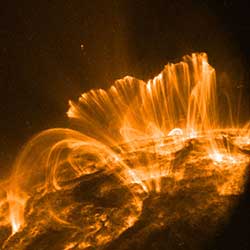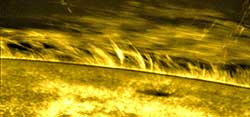The Sun as an X-ray Source
The Sun has a surface temperature of approximately 6,000 Kelvin, or around 10,000 degrees Fahrenheit. The solar surface emits most of its electromagnetic radiation as visible light, or the portion of the electromagnetic spectrum we can see with our eyes. A 6,000 K star should be an extraordinarily weak source of X-rays.
In the late 1940s, sounding rocket experiments showed that the Sun is, in fact, a very strong X-ray emitter. Astronomers were surprised! What's going on?
The X-rays we detect from the Sun do not come from the Sun's surface, but from the solar corona, which is the upper layer of the Sun's atmosphere. Only very hot gases can emit X-rays, and the corona, at millions of degrees, is hot enough to emit X-rays, while the much cooler surface of the Sun is not. Thus, the Sun's atmosphere is an excellent source of X-rays.
Credit: NASA/SDO and the AIA science team
However, the discovery of the hot corona created a problem for astronomers and physicists. Simply stated, the problem is this: The corona is hot, the Sun is not (relatively speaking). So how does a surface that is about 6,000 Kelvin heat an atmosphere to a million Kelvin?
The mechanism by which the solar corona is heated is still not fully understood, but there are currently two mechanisms that astronomers think might do the trick.
In the introduction to the Sun, we mentioned that the Sun has an 11-year cycle of sunspots that have been observed over the past 140 years. There is a corresponding cycle of behavior seen in the corona with the same timescales.


As the solar activity cycle progresses from maximum to minimum, the Sun's magnetic field changes from a complex structure to a simpler configuration with fewer fields. Since the Sun's hot gases are controlled by these fields, the X-ray images reflect this global change, with an overall decrease in brightness by a factor of 100.
There are a couple ways the corona could be heated through magnetic interactions. One way is heating due to coronal loops reconnecting and snapping. A second way is through waves that originate below the Sun's surface bubbling up and delivering magnetic energy to the corona.
Until recently, researchers have not been able to show which of these methods could deposit enough energy to produce the X-ray emission we see. In 2013, a pair of astronomers (Hahn and Savin) published findings in The Astrophysical Journal that suggest the magnetic waves could be the answer. We'll have to stay tuned to see if they had the definitive answer.
Updated: February 2014
Additional Links
- Quiz me about this topic
- Cool fact about this topic
- Try this!
- FAQs on the Sun and the Solar System.
- Introductory-level article on this topic
- Give me additional resources


